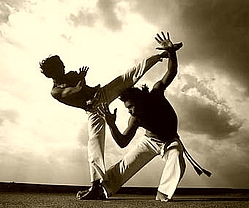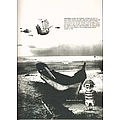Capoeira Biography
Capoeira (IPA: [ka.pu.ˈej.ɾɐ]) is an Afro-Brazilian art form that makes a ritual of movements from martial arts, games, and dance. It was brought to Brazil from Angola some time after the 16th century in the regions known as Bahia, Pernambuco and Rio de Janeiro. Participants form a roda or circle and take turns either playing musical instruments (such as the Berimbau), singing, or ritually sparring in pairs in the center of the circle. The game is marked by fluid acrobatic play, feints, and extensive use of sweeps, kicks, and headbutts. Less frequently used techniques include elbow-strikes, slaps, punches, and body throws. Its origins and purpose are a matter of debate, with the spectrum of argument ranging from views of Capoeira as a uniquely Brazilian folk dance with improvised fighting movements to claims that it is a battle-ready fighting form directly descended from ancient African techniques. Music! Music is integral to capoeira. It sets the tempo and style of game that is to be played within the roda. The music is composed of instruments and song. The tempos differ from very slow (Angola) to very fast (são bento regional). Many of the songs are sung in a call and response format while others are in the form of a narrative. Capoeiristas sing about a wide variety of subjects. Some songs are about history or stories of famous capoeiristas. Other songs attempt to inspire players to play better. Some songs are about what is going on within the roda. Sometimes the songs are about life or love lost. Others are lighthearted or even silly things, sung just for fun. Capoeiristas change their playing style significantly as the songs or rhythm from the berimbau commands. In this manner, it is truly the music that drives capoeira. There are three basic kinds of songs in capoeira[citation needed]. A ladainha (litany) is a narrative solo usually sung at the beginning of a roda, often by the mestre (master). These ladainhas will often be famous songs previously written by a mestre, or they may be improvised on the spot. A ladainha is usually followed by a chula or louvação, following a call and response pattern that usually thanks God and one's teacher, among other things. Each call is usually repeated word-for-word by the responders. The ladainha and chula are often omitted in regional games. Finally, corridos are songs that are sung while a game is being played, again following the call and response pattern. The responses to each call do not simply repeat what was said, however, but change depending on the song. The instruments are played in a row called the bateria. Three instruments are berimbaus, which look like an archer's bow using a steel string and a gourd for resonance. It is played by striking the string with a stick, and the pitch is regulated by a stone. Legend has it that, in the old times, knives or other sharp objects were attached to the top of the berimbau for protection and in case a large fight broke out. In 'the little book of capoeira' - 'Nestor Capoeira, It is said Mestre Pastinha would tell of a small sickle sharpened on both edges which he would keep in his pocket. He was fond of saying "If it had a third edge I would sharpen that one too, for those who wish to do me harm." Pastinha also spoke of how this blade could be attached to the end of a berimbau. These three bows are the Berra boi (also called the bass or Gunga), Medio, Viola, and lead the rhythm. Other instruments in the bateria are: two pandeiros (tambourines), a reco-reco (rasp), and an agogo (double gong bell). The atabaque (conga-like drum), a common feature in most capoeira baterias, is considered an optional instrument, and is not required for a full bateria in some groups.
Capoeira Lyrics
| Title | |
|---|---|
| 1 | Aruanda E lyrics |
Write a comment
What do you think about Capoeira? Let us know in the comments below!









